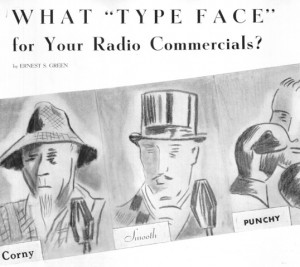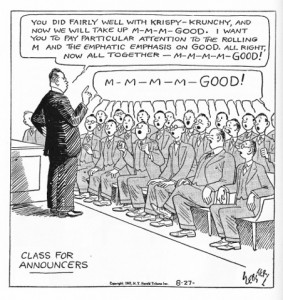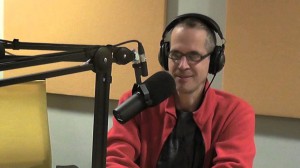On Radio: Authenticity and Sincerity in Podcast Advertising

This 1938 trade press article argues that choosing the announcer to voice the commercial is similar to choosing the correct typeface for a print ad.
As podcasters draw larger audiences, they are experimenting with business models, especially with advertising.
Like many media historians, I’ve been struck by the parallels between 1920s-30s radio and 2010s podcasting. Despite obvious differences between podcasting and early radio—such as asynchronous reception, niche rather than mass audiences, global rather than local distribution—podcasters hoping to support themselves by advertising share many of the opportunities and difficulties faced by the producers of Jack Benny and Kraft Music Hall.
When radio emerged in the 1920s, its boosters promised it would be an effective advertising medium because, instead of inert printed text, it used the human voice, which “tug[s] at heartstrings,” according to Radio Showmanship, and “affects the heart, mind, and soul,” according to a 1929 CBS pamphlet. Podcaster Alix Spiegel (Invisibilia) has recently made a similar claim about the emotional information carried in voices.
Early radio advertising proponents noted that audiences experienced radio as individuals rather than as masses, in the intimacy and privacy of the home, making it feel like a more confidential and personalized medium than, say, films in theaters. Likewise, some podcasters today note the high “engagement” they enjoy with their audiences, many of whom, listening on headphones or earbuds, are far more attentive than audiences for whom radio or television is sonic wallpaper. Advertisers who fear television audiences have strayed to other screens may find podcast audiences more appealing. As one podcaster explains, “People really pay attention to the ads,” so advertisers may pay very high prices (CPMs) to reach them.

The cartoonist H. T. Webster poked fun at announcers perfecting their commercial delivery.
Early radio proponents, such as a NBC time salesman, noted radio’s “pseudo-friendship” effect, when audiences’ parasocial relationships with radio personalities spilled over into their perceptions of whichever products those personalities endorsed. Likewise, some podcasters today, such as Mark Maron and the hosts of Men in Blazers, are asked by advertisers to promote products by integrating endorsements or uses of products into their podcasts, allowing brands to leverage the audience’s good will toward the host. Such “testimonials,” an established strategy in print advertising before the radio era, also had a long history in radio and television, as hosts such as Mary Margaret McBride and Arthur Godfrey integrated product endorsements into their talk shows.
However, advertisers do run some risks when closely tying the commercial message to the host or announcer’s personality. In early radio, some suggested that announcers delivering advertising messages must sound “sincere” or risk losing audience trust. The commercial’s words, according to Norman Brokenshire, a well-known announcer, must be “felt as well as spoken.” Likewise, StartUp podcaster Alex Blumberg, who uses first-person narratives and interviews in both his program and advertising, has insisted that he selects his advertisers carefully so that any implied endorsement by him is sincere and authentic.
In the 1930s the ad agency J. Walter Thompson would sometimes, instead of professional announcers, have an amateur or “man on the street” speak the commercial message; this, the ad agents believed, could make the advertising sound “more sincere, frank, and open.” Likewise, podcaster Roman Mars (99% Invisible) often uses soundbites of his own child speaking about his advertisers, and the producers of Serial, most famously, use “man on the street” interviews for their commercial for MailChimp. The interviewee who notoriously mispronounced the name as “Mail Kimp” reinforced the authenticity of the ad.
In 1920s radio, producers worried at first that audiences would turn off the radio if the program were interrupted by ads. Today audiences can easily avoid interruptive ads, and so podcasters feel a special need to keep them listening. Blumberg’s ads in StartUp, for example, resemble the rest of the show; as he interviews his documentary sources about his topic, so he interviews his sponsors about their business, with no change in style or tone. The similarity is so close, in fact, that he employs a special music cue so that listeners won’t confuse the ad with the program.
This integration of format or style between program and commercial was routine in 1930s-40s radio. Comedian Fred Allen made jokes with announcers about sponsors, and Jack Benny famously integrated humorous references to Jell-O into his comedy. The intention was not to confuse audiences but to smooth out any disjunctures and keep audiences listening.

Alex Blumberg of Gimlet Media & the StartUp podcast (Image: The Wolf Den/Midroll Media)
Blumberg has already confronted one of the pitfalls of such integrations. For his company’s other program, Reply All, the producer used an interview with a young boy about his use of the web site provider Squarespace as an advertisement for that site. The boy, and his mother, thought the interview was for the program, not an ad, and the mother’s sense of offense was rapidly transmitted via social media. In a perfectly reflexive and reflective episode about this event, Blumberg interviewed the mother, who noted that her son, unlike a hired performer, was offered no compensation for his testimonial. So Blumberg’s production of authentic ads via documentary-style soundbites has to gain the trust not just of the audience but also of the documentary subjects.
In some ways, then, podcasting is where radio was in the late 1920s, promising to be a new medium but like old media simultaneously. Advertisers’ need to reach attentive audiences has increased as audiences have been unshackled from linear media’s schedules and forced exposure to advertising. As podcasters try to monetize programming, maintaining their audiences’ trust and attention will be crucial to their success, and that, in turn, will depend in part on how they handle their advertising.



I can definitely see parallels. I’m an avid listener of “The Mike O’Meara Show”, and most of their advertisements are a minute here or there at the beginning of show “segments.” However, sometimes they will devote an entire show to having a local wine shop owner in while they sample wines throughout the show. I generally find this format to be the least interesting, but maybe that’s because I’m not a wine aficionado. On the other hand, it’s really no different from when the local morning shows here do a “Beer Friday” and have a beer expert on for an hour. For a podcast trying to get by on advertising revenue, “TMOS” does a good job of occasionally reminding listeners that supporting the advertisers is how they make their living, so it certainly builds solidarity in the audience.
[…] In case you missed it, I recently wrote about some of the parallels I hear between some podcast advertising and the advertising of “golden age” radio. In both eras, concerns about keeping audience attention–and not annoying audiences–shape some advertising strategies. You can read the full Antenna post here. […]